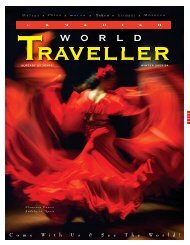Canadian World Traveller Spring 2018 Issue
Now in our 16th year of publishing, Canadian World Traveller explores the culture and history of worldwide destinations, sharing the adventure of discovery with our readers and motivating them to make their travel dreams a reality. Published quarterly, CWT helps sophisticated, independent Canadian travellers choose their next destination by offering a lively blend of intelligent, informative articles and tantalizing photographic images from our World’s best destinations, cruises, accommodations and activities to suit every traveller's taste.
Now in our 16th year of publishing, Canadian World Traveller explores the culture and history of worldwide destinations, sharing the adventure of discovery with our readers and motivating them to make their travel dreams a reality. Published quarterly, CWT helps sophisticated, independent Canadian travellers choose their next destination by offering a lively blend of intelligent, informative articles and tantalizing photographic images from our World’s best destinations, cruises, accommodations and activities to suit every traveller's taste.
Create successful ePaper yourself
Turn your PDF publications into a flip-book with our unique Google optimized e-Paper software.
County Wicklow<br />
We hit the pedal to the metal and veer<br />
straight into the Garden of Ireland in County<br />
Wicklow. The bold moniker is due to a collection<br />
of fine garden estates.<br />
At Killruddery House, the 17th century gardens<br />
are the oldest in Ireland. A noblesse<br />
nod to the Gardens of Versailles (the<br />
Huguenet gardener modeled Killruddery’s<br />
after Versailles), the long mirroring ponds<br />
stretch beyond the grand residence which<br />
has been a stand-in for movie blockbusters,<br />
among them “The Tudors.” In the garden,<br />
guests enjoy tea afternoons and embark on<br />
a fascinating guided house tour.<br />
Home to the Earl of Meath, the Brabazon<br />
family has resurrected a Tudor Revival<br />
Mansion masterpiece from post-<strong>World</strong> War<br />
II neglect when the then Earl resided elsewhere.<br />
Today, visitors can explore this living<br />
working house garden and farm, which<br />
since 1618 has been home to 16 generations<br />
of the Brabazon family. The rooms are<br />
bedecked in original art and furnishings,<br />
most of which were culled in the 1800s during<br />
a 3-year buying trip to mainland Europe<br />
by John Chambre Brabazon, the 10th Earl<br />
of Meath’s eldest son William and daughterin-law<br />
Harriet.<br />
The Orangery is a token to the lady of the<br />
house, Harriet who sold her tiara to create<br />
this glass statement piece inspired by the<br />
Crystal Palace in London. The private residence<br />
is revered as the most successful<br />
Elizabethan-Revival mansion in Ireland.<br />
Ironically 30-minutes south from this House<br />
of Fortune a whole different world unravels<br />
at the Wicklow Gaol. Thrill seekers dare to<br />
enter one of the most haunted places in<br />
Ireland. They say those who were locked<br />
away there in the 18th century are still in<br />
residence. The House of Horror incarcerated<br />
thousands during Ireland’s harshest history<br />
(think the 1798 Revolution, the Great<br />
Famine, and the 1916 Easter Rising). I took<br />
my own personal ghostly encounter and<br />
filed the experience under ‘unexplainable’<br />
counting my lucky stars that this unexpected<br />
discovery was one of many along a trek I<br />
took along Ireland’s Ancient East Coast.<br />
Throughout this storybook setting, the landscape<br />
morphs into a quilt of rural scenes<br />
held together by fields of green. No big billboards<br />
here. It’s just the wide expanse of<br />
blue skies hitting the hillsides to palatial<br />
places like Powerscourt, owned by tennis<br />
ball tycoon, the Slazenger family. Rounded<br />
mounds named Little Sugar Loaf Mountain<br />
(known for its quartzite) for the obscure<br />
shape seem to have been created by giants.<br />
In between the 50 shades of green proud<br />
homeowners care for their immaculate cottages,<br />
cows graze in the pastures, while<br />
ruins of ancient kingdoms litter the countryside<br />
– a testament to Ireland’s deep-rooted<br />
history.<br />
County Meath<br />
Mel Gibson’s blockbuster Braveheart was<br />
filmed in Ireland’s oldest Anglo-Norman<br />
castle. Now visitors amble to the rooftop of<br />
Trim Castle, the town’s biggest tourist attraction<br />
and head inside a mini-museum of<br />
Braveheart clad costumed volunteers who<br />
were extras in the movie to showcase<br />
medieval military wardrobes and weaponry<br />
to kids and day trippers.<br />
Considered the New York of Medieval<br />
Ireland, Trim was a hot bed of industry, commerce<br />
and skilled labourers converging on<br />
the River Boyne with a state-of-the-art mint<br />
and a sewer system. These days, paddlers<br />
float upriver to see more medieval buildings<br />
than anywhere in Ireland. The biggest, the<br />
largest and the oldest like Ireland’s first<br />
unaltered bridge built in 1393 are within a<br />
4-minute stretch.<br />
County Wexford<br />
In Hook Head, the sea opens up. The<br />
rugged peninsula tickles the imagination on<br />
what once was. In the past, the sea has<br />
swallowed hundreds of ships, sending many<br />
a vessel and all its mariners to a watery<br />
grave. William Marshall, Earl of Pembroke<br />
and Strongbow’s son-in-law, who was a<br />
powerful knight of his day, erected this lighthouse<br />
to divert ships from the treacherous<br />
Irish Sea.<br />
Considered the world’s oldest operational<br />
lighthouse, the 800-year-old Hook<br />
Lighthouse is a black and white cylinder that<br />
topples the pancake plain. Visitors partake<br />
in a guided lighthouse tour fueled with hologrammed<br />
characters narrating stories and<br />
ascend the corckscrew 115-steps to the<br />
observatory for birds’ eye views.<br />
Hook Head also lays claim to the country’s<br />
most notorious haunted house. At Loftus<br />
Hall, those who dare to mingle with spirits<br />
embark on a peculiar guided tour in the<br />
dark. The resident ghost, a young woman<br />
named Lady Anne is known to appear when<br />
least expected.<br />
We leave Hook Head behind with its gales<br />
and tales, ready to take another detour<br />
along Ireland’s Ancient East. Who knows<br />
what fairytale or ghostly apparition will<br />
come to life around the bend.<br />
www.ireland.com<br />
51<br />
<strong>Canadian</strong> <strong>World</strong> <strong>Traveller</strong> <strong>Spring</strong> <strong>2018</strong>
















